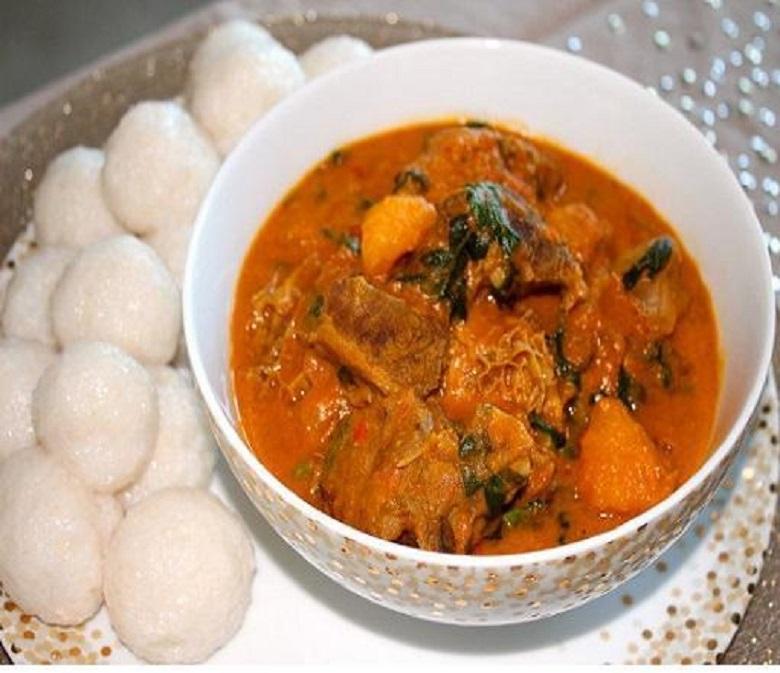Hausa foods are the traditional and modern foods prepared by the Hausa people; they are based on the availability of raw food that they can grow or provide elsewhere; most of the time, the Hausa people rely purely on the food they cultivate.
The Hausa are Nigeria’s largest tribe, with over 55 million people living in Nigeria alone. They can found in many other African countries, such as Cameroon, Benin, Sudan, Ghana, Togo, Chad, Congo, and Niger. The Hausa people live mainly in northern Nigeria. Most of them are farmers and traders; however, a significant number of them involves in production.
Hausa tribe are known for their unique dressing that is different from other cultures in Nigeria. The Hausa are also responsible for some of the culinary delicacies consumed in Nigeria.
Hausa foods are pretty yummy, and most of them are easy to make.
Different types of traditional Hausa foods
1. Miyan Geda (Groundnut soup)
Miyan Geda is a tasty soup commonly found in northern Nigeria. The main ingredient in Miyan Geda is groundnut. This delightful recipe can be prepared in less than 50 minutes and is especially rich in protein and fiber.
Miyan Geda can serve with any swallow (fufu, Eba, Semo, Tuwo Shinkafa, etc.).
2. Furra Da Nono
Fura Da Nono is a type of Hausa food similar to yogurt. It is naturally fermented milk that has a thick consistency. It is usually made by forming the fura into balls and mashing the fura into milk.
It is rich in nutrients that provide many health benefits to the body. It is rich in protein, calcium, magnesium, and niacin.
It helps build healthy, strong bones, reduces the risk of heart attacks, and lowers bad cholesterol in everybody’s cell.
3. Tuwo Shinkafa
Tuwon Shinkafa is a Nigerian and Nigerian dish from Niger and northern Nigeria. It is a thick pudding made of local rice or maize or millet, soft and sticky, usually served with different types of soups such as Miyan Kuka, Miyan Kubewa, MiyanTaushe.
It is also a good substitute for fufu and Eba if you are watching your cholesterol or gluten intake.
4. Miyan Zogale (moringa soup)
Miyan Zogale, known as Moringa soup, is a popular and delectable delicacy in Northern Nigeria. Perfect for weight loss, the medicinal properties of moringa are tremendous.
5. Dan wake
Dan awake is made from bean flour, pepper, Kuka, and potash. It mainly eats in northern Nigeria. It usually serves with ground peppers known as (Yaji); you can also select Suya peppers and vegetables.
6. Suya
Suya is one of the common Hausa foods and one of the few Hausa foods consumed in almost every region of Nigeria. Making suya is very easy and should not take too much time; however, the taste properly is different.
7. Tuwo Masara (cornmeal)
Maize flour (Tuwo Masara) is a staple food and a very popular fufu swallow in northern Nigeria. It has different names; some people call it maize flour fufu or maize swallow. In Hausa, it is known as tuwon masara or tuwo.
It can be served with any soup, depending on your choice.
8. Masa (rice cake)
Masa made from Tuwo rice. It is a special delicacy made mainly in northern Nigeria. Masa is yummy and often enjoy with Miyan Taushe (another Hausa delicious soup). It can also consume with Yaji ( spicy pepper).
9. Kunun Gyada
It is a staple food in northern Nigeria, similar to pap ( Ogi, Akamu), made from grains. Non-alcoholic beverages from the north are called Kunun, and each name after the key ingredient used to make them.
Kunun Gyada is a thin, free-flowing porridge made from groundnuts. It has the ideal combination of sweet and slightly sour taste, with the sourness coming from tamarind or lemon juice added.
10. Miyan Kuka (Baobab leaves) soup
Miyan Kuka is a northern Nigerian soup made from dried baobab leaves. It is also known as baobab leaf soup. Baobab trees are abundant in the north of Nigeria, and the leaves harvest dried and ground into a beautiful green powder. The leaves are so nutrient-dense that the tree calls the “tree of life.”
Miyan Kuka is not a very attractive soup; it is gummy and green. It looks like Ogbono soup but has a different color. The color maybe a little off-putting to first-time eaters, but it lacks visual appeal; it’s not just about taste and flavor. It is one of those dishes that taste better when heated and served the next day.
This soup is especially beneficial for mothers after childbirth due to its high protein levels, vitamin B, and folic acid.
